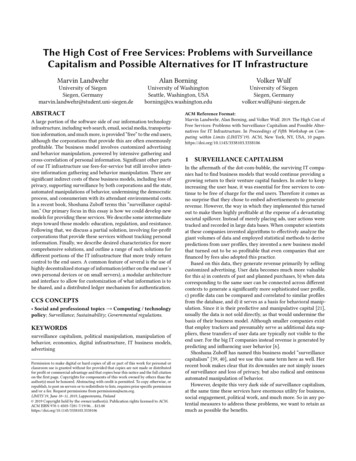
Transcription
The High Cost of Free Services: Problems with SurveillanceCapitalism and Possible Alternatives for IT InfrastructureMarvin LandwehrUniversity of SiegenSiegen, Germanymarvin.landwehr@student.uni-siegen.deAlan BorningUniversity of WashingtonSeattle, Washington, USAborning@cs.washington.eduABSTRACTA large portion of the software side of our information technologyinfrastructure, including web search, email, social media, transportation information, and much more, is provided “free” to the end users,although the corporations that provide this are often enormouslyprofitable. The business model involves customized advertisingand behavior manipulation, powered by intensive gathering andcross-correlation of personal information. Significant other partsof our IT infrastructure use fees-for-service but still involve intensive information gathering and behavior manipulation. There aresignificant indirect costs of these business models, including loss ofprivacy, supporting surveillance by both corporations and the state,automated manipulations of behavior, undermining the democraticprocess, and consumerism with its attendant environmental costs.In a recent book, Shoshana Zuboff terms this “surveillance capitalism.” Our primary focus in this essay is how we could develop newmodels for providing these services. We describe some intermediatesteps toward those models: education, regulation, and resistance.Following that, we discuss a partial solution, involving for-profitcorporations that provide these services without tracking personalinformation. Finally, we describe desired characteristics for morecomprehensive solutions, and outline a range of such solutions fordifferent portions of the IT infrastructure that more truly returncontrol to the end users. A common feature of several is the use ofhighly decentralized storage of information (either on the end user’sown personal devices or on small servers), a modular architectureand interface to allow for customization of what information is tobe shared, and a distributed ledger mechanism for authentication.CCS CONCEPTS Social and professional topics Computing / technologypolicy; Surveillance; Sustainability; Governmental regulations.KEYWORDSsurveillance capitalism, political manipulation, manipulation ofbehavior, economics, digital infrastructure, IT business models,advertisingPermission to make digital or hard copies of all or part of this work for personal orclassroom use is granted without fee provided that copies are not made or distributedfor profit or commercial advantage and that copies bear this notice and the full citationon the first page. Copyrights for components of this work owned by others than theauthor(s) must be honored. Abstracting with credit is permitted. To copy otherwise, orrepublish, to post on servers or to redistribute to lists, requires prior specific permissionand/or a fee. Request permissions from permissions@acm.org.LIMITS’19, June 10–11, 2019, Lappeenranta, Finland 2019 Copyright held by the owner/author(s). Publication rights licensed to ACM.ACM ISBN 978-1-4503-7281-7/19/06. . . 15.00https://doi.org/10.1145/3338103.3338106Volker WulfUniversity of SiegenSiegen, Germanyvolker.wulf@uni-siegen.deACM Reference Format:Marvin Landwehr, Alan Borning, and Volker Wulf. 2019. The High Cost ofFree Services: Problems with Surveillance Capitalism and Possible Alternatives for IT Infrastructure. In Proceedings of Fifth Workshop on Computing within Limits (LIMITS’19). ACM, New York, NY, USA, 10 EILLANCE CAPITALISMIn the aftermath of the dot-com-bubble, the surviving IT companies had to find business models that would continue providing agrowing return to their venture capital funders. In order to keepincreasing the user base, it was essential for free services to continue to be free of charge for the end users. Therefore it comes asno surprise that they chose to embed advertisements to generaterevenue. However, the way in which they implemented this turnedout to make them highly profitable at the expense of a devastatingsocietal spillover. Instead of merely placing ads, user actions weretracked and recorded in large data bases. When computer scientistsat these companies invented algorithms to effectively analyze thegiant volumes of data and employed statistical methods to derivepredictions from user profiles, they invented a new business modelthat turned out to be so profitable that even companies that arefinanced by fees also adopted this practice.Based on this data, they generate revenue primarily by sellingcustomized advertising. User data becomes much more valuablefor this a) in contexts of past and planned purchases, b) when datacorresponding to the same user can be connected across differentcontexts to generate a significantly more sophisticated user profile,c) profile data can be compared and correlated to similar profilesfrom the database, and d) it serves as a basis for behavioral manipulation. Since it is their predictive and manipulative capital [21],usually the data is not sold directly, as that would undermine thebasis of their business model. Although smaller companies existthat employ trackers and presumably serve as additional data suppliers, these transfers of user data are typically not visible to theend user. For the big IT companies instead revenue is generated bypredicting and influencing user behavior [6].Shoshana Zuboff has named this business model “surveillancecapitalism” [39, 40], and we use this same term here as well. Herrecent book makes clear that its downsides are not simply issuesof surveillance and loss of privacy, but also radical and ominousautomated manipulation of behavior.However, despite this very dark side of surveillance capitalism,at the same time these services have enormous utility for business,social engagement, political work, and much more. So in any potential measures to address these problems, we want to retain asmuch as possible the benefits.
LIMITS’19, June 10–11, 2019, Lappeenranta, FinlandTo relate this analysis to work presented at LIMITS 2018 [4]and elsewhere [3], the SEED1 project is based on the observationthat quality of life for growing numbers of people on the planetis threatened by a set of integrated, systemic problems in the environment and our economic and political systems. Its goal is toform an international network of scholar/activists, advocates, andpractitioners who seek to address these problems in a similarlyintegrated fashion. The work presented here is a step in workingout how the SEED ideas play out in a particular economic sector,namely IT. (We can imagine similar efforts in the future for othersectors.)In describing SEED, we put forth an ideal of the relationshipamong the environment, society, government, and the economy,firmly grounded in the natural world. Within and bounded by thenatural world is human society, with a goal of prosperity for all andsupporting human flourishing. Government in turn is subservientto society, and finally the economy is subservient to all three othersystems. This vision is in sharp contrast to our current system,in which the economy takes priority. A major added problem ofsurveillance capitalism is thus: in addition to making the naturalworld subservient to and serving the needs of the economy, nowhuman nature is being similarly dominated.In the following section we discuss the processes by whichsurveillance capitalism impacts consumerism, threatens democracy, fuels social fragmentation, undermines our ability to tacklemajor environmental problems, and thereby ultimately constitutesa hurdle to living within planetary ecological limits. While a number of leaders in those IT companies were well aware of a rangeof negative effects on society [1, 25], in the past these effects havebeen underrecognized by major parts of society.2PROBLEMSThis business model produces a range of problems. In order to maximize the value for advertisers the companies need to capture theuser for as long as possible on the website or using the application.This is achieved by applying knowledge of human psychology [22]and experimenting with different interfaces using A/B and othertesting. (Another more publicized example of manipulation is theFacebook emotional manipulation study [13].)One strategy to maximize the time spent on social media is topush toward more provocative content, both on the side of theviewer (who becomes more engaged or outraged when confrontedwith extreme positions, so that feeds tend to select for such content [34]), and also on the side of the contributor (since these poststhen tend to receive more positive feedback, encouraging users topost more in that direction). This feedback loop is just one examplebased in a kind of psychological trap. Other strategies are to triggeranxieties (fear of missing out (FOMO) or how one compares withothers), or exploit tendencies toward certain kinds of addiction.Overall these methods aim to result in a strong pull toward thewebsite, platform or application.In addition to maximizing the number of people who see anadvertisement and the length of time they attend to it, the ad alsobecomes much more effective if seen by groups most likely to respond to it. IT companies that gather personal user information1 Solutionsfor Environment, Economy and DemocracyMarvin Landwehr, Alan Borning, and Volker Wulfnot only identify the users as members of particular groups, theyalso use their elaborate algorithmic tools of statistical analysis toidentify for the advertiser which target group to aim for [6, 22].However, in order to provide these services to the advertiser, thecompany needs to gather and correlate more and more personalinformation. There are three things happening. The first is the gathering of any available possibly relevant raw information by trackingthe user, including actions taken in the browser, contact addresses,and the mobile location. In addition, if the records that belong to agiven person can be connected during a series of visits and betweendifferent websites and applications, a far more sophisticated userprofile is generated. This is the reason these websites use trackersthat are able track the entire activity during the browser session. Itis also a reason that Facebook and Google are highly motivated forusers to log in with their accounts for identification to other serviceproviders. Third, the correlation of many of these sophisticated userprofiles makes it possible to statistically make predictions aboutuser behavior, and thereby understand the users possibly betterthan they understand themselves.Another practice is the manipulation of user behavior, not justsurveillance. One motivation for this is that predictions about userbehavior can be made more precise if those behaviors can be nudgedin particular directions, making those predictions even more valuable for the surveillance capitalist firm’s customers, namely theadvertisers. However, if the manipulation is no longer directed justat improving predictions to make them more valuable to advertisers, but instead (for example) to strengthening a particular politicalopinion or nudging a citizen toward voting a given way, the ITcompany has developed a tool that can wield significant power andcontrol over civic life.Above we noted the effect of this business model on the orientation of these IT companies. We now explore the outcomesfor individuals and society, including how the intensive gathering,tracking, and correlation of personal information, along with behavioral manipulation, poses a threat to sustainable economies anddemocracies in multiple dimensions.2.1Consumerism and Excessive ConsumptionThe increasing precision and effectiveness of customized advertising serves the imperative for consumption and unending growth.The generation of artificial needs is valuable to the advertisers,which can serve these needs, while having a destructive influenceon the individual as well as society. On the individual level the userspay twice for these artificially generated needs, while true needsremain unsatisfied: once with the money of their purchases; and thesecond time with the time they spend due to the provocative content and in psychological traps. On the level of society, (1) personalinformation bubbles amplify social fragmentation and thereby hinder effective action on global problems/challenges, while (2) such alevel of consumption cannot be sustained within ecological limits.Let us now examine these two outcomes more closely.2.2Threats to Government and DemocraticProcessesSocial media platforms such as Twitter, Facebook, and Instagramoffer new types of (semi-)public spaces. They play an increasingly
The High Cost of Free Servicesimportant role in the exchanges of ideas, visions, and convictionsthat are central to civic life. However, the algorithms by which content is selected are often opaque to the reader [2]. On the one hand,these public spaces can have an emancipatory effect, for exampleunder conditions of surveilled telephone lines and censored massmedia, as occurred in the early stages of the Arab Spring whendiscussions critical of the regime, planning for demonstrations, andthe distribution of news were facilitated by these platforms [30, 38].On the other hand, the content of these exchanges will be recordedby the platforms and can contribute to the personal profiling of thediscussants. Thus, these semi-public spaces have a Janus nature.They offer emancipatory potential, but at the same time contributeto the refinement of personal profiles and opportunities for manipulation. The role of Facebook in the 2016 U.S. election and theappropriation of the Whatsapp messenger in the recent electionsin Brazil shows the manipulative power that comes with the ability to create personal profiles and to distribute targeted politicalpropaganda via social media platforms [18, 33].A lack of privacy with regard to political communication o
Facebook emotional manipulation study [13].) One strategy to maximize the time spent on social media is to push toward more provocative content, both on the side of the viewer (who becomes more engaged or outraged when confronted with extreme positions, so that feeds tend to select for such con- tent [34]), and also on the side of the contributor (since these posts then tend to receive more .











